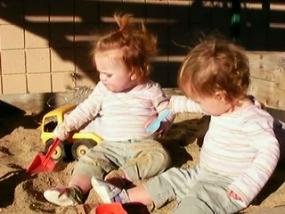Siblings in the Sandbox

Lydia and Amelia sit comfortably together playing in the sand. Amelia repeatedly pours sand on her sister’s leg. Why? Let’s first think about what Amelia does not do. Notice that Amelia does not look up at her sister as if she expects a reaction. She does not set the spoon directly on Lydia’s leg as if to deposit the sand in a particular location; therefore she is probably not interested in making the pile taller. Amelia does observe how the sand lands on Lydia’s leg. The color contrast allows her to see the effect of the falling sand. If she poured sand directly into the box, then the spatter would be undetectable. From these observations, we speculate that Amelia is most interested in how to vary the effect of the sand as it falls.
Amelia’s pouring action catches Lydia’s attention. Lydia stops pouring sand in the box and shifts to pouring sand on her own leg. She thereby shows she can generalize what she sees Amelia doing with a spoon to what she can do with a shovel. Next she places and releases the shovel on her leg to catch the sand Amelia pours. There are two reasons this action is interesting. Lydia shows us that she has shifted from thinking about the shovel as a hand tool for pouring sand to a passive container for receiving sand. Then she shifts back to the hand-tool use and lifts the sand-laden shovel to pour the sand out, thereby creating a sort of accidental collaboration with Amelia, “I pour what you poured.” As you continue watching, look for examples of how one sister’s action elicits something similar from the other. And watch how first Amelia, then Lydia, allow their respective arms to be moved by the other as they both work with the same spoon. There is something rather special about how twins learn to play together. What one sister does the other sister uses. Instead of conflict, we watch a dance.
Length of stand-alone master video clip: 3 minutes 51 secs
Highlight the text above and paste to a document to have your own copy.
Keywords: Ones, Children-Object, Non-Verbal, Cause/Effect
